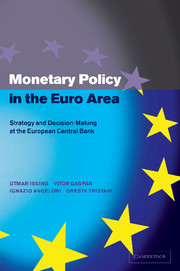Book contents
- Frontmatter
- Contents
- List of figures
- List of tables
- Acknowledgements
- Introduction
- 1 Money, output and prices: the scope of monetary policy
- 2 Monetary policy making: strategies and rules
- 3 The euro area: an overview
- 4 The ECB strategy: defining price stability
- 5 The role of money
- 6 A broadly based assessment
- 7 The ECB strategy: an overall view
- 8 The operational framework
- 9 Accountability and transparency
- 10 The single monetary policy in 1999
- Appendix Excerpts from ECB external communications to the press
- References
- Index
7 - The ECB strategy: an overall view
Published online by Cambridge University Press: 22 September 2009
- Frontmatter
- Contents
- List of figures
- List of tables
- Acknowledgements
- Introduction
- 1 Money, output and prices: the scope of monetary policy
- 2 Monetary policy making: strategies and rules
- 3 The euro area: an overview
- 4 The ECB strategy: defining price stability
- 5 The role of money
- 6 A broadly based assessment
- 7 The ECB strategy: an overall view
- 8 The operational framework
- 9 Accountability and transparency
- 10 The single monetary policy in 1999
- Appendix Excerpts from ECB external communications to the press
- References
- Index
Summary
In previous chapters, we have examined in some detail the main building blocks of the ECB monetary policy strategy. We will take that as our starting point in the attempt to offer, in this chapter, a comprehensive overview of the strategy as a whole. We will focus, specifically, on the interaction among those building blocks in the process leading to monetary policy decisions.
To summarise the discussion of the last two chapters, the ECB's stability oriented monetary policy strategy includes three main elements: (1) a precise definition of price stability; (2) the analysis of monetary developments; (3) the analysis of a wide range of economic and financial indicators.
Price stability is to be maintained over a medium term horizon. The medium term orientation shows two important general features of the strategy. First, the return to price stability after an inflationary or deflationary shock will be gradual, hence avoiding any unnecessary volatility in output and interest rates. Second, the existence of monetary policy transmission lags is explicitly acknowledged. As a result, policy has to be forward looking and react to current developments mainly to the extent that they convey information on future risks to price stability.
In this respect, the prominent role of money and the broadly based assessment assume the symbolic role of ‘pillars’ of the strategy itself. The two pillars, considered separately, were extensively discussed in previous chapters, and we shall not return to them here.
- Type
- Chapter
- Information
- Monetary Policy in the Euro AreaStrategy and Decision-Making at the European Central Bank, pp. 98 - 111Publisher: Cambridge University PressPrint publication year: 2001



